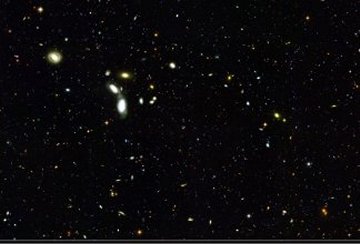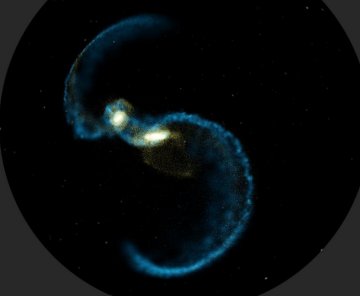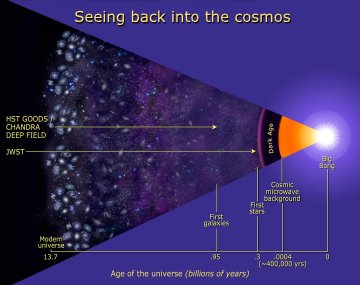Strange Universe: The Stuff of Darkness
Figuring out what's hidden in outer space between the visible stars and galaxies isn't easy.
By Emily Sohn
It isn’t easy to study darkness.
Try it. Next time you’re outside on a clear night, look up. You might see the winking lights of an airplane, the glow of an orbiting satellite, or even the bright trail of a meteor. Of course, you’ll see lots of stars.
What about all the space between the stars? Is something hidden out there in the darkness? Or is it merely empty?
 |
|
Is there anything in the dark areas between distant galaxies?
|
| NASA, ESA, the GOODS Team, and M. Giavalisco (STScI) |
There’s nothing for the human eye to see, but astronomers are finding ways to detect what lies between the stars. And they’re discovering that most of the universe is made out of mysterious, invisible stuff. They call it dark matter and dark energy.
Although they can’t see it directly, scientists are pretty sure this weird stuff exists. Figuring out exactly what it is, however, remains a work in progress.
“We’re just now beginning to peel away the darkness,” says Robert Kirshner, an astronomer at Harvard University. “We’re beginning to see what things are really like, and it’s a funny, very unsettling picture because it’s so new and unfamiliar.”
Ordinary matter
When you look around, everything you see is a type of matter. This is the ordinary stuff of the universe, from a grain of salt to a drop of water to a candy bar. You are matter. So is Earth, the moon, the sun, and our own Milky Way galaxy.
Simple enough, right? Until about 1970, our picture of the universe seemed this straightforward. But then Jeremiah Ostriker of Princeton University and other astronomers started to notice something curious.
Gravity provided the hint. The force of gravity keeps us stuck to the ground, the moon in orbit around Earth, and Earth in orbit around the sun. Without gravity, these bodies would fly off on their own.
In general, the force of gravity between any two objects depends on the distance between them and on the amount of matter, or mass, in each object. The sun, for example, contains a lot more matter than Earth, so it has a much larger mass and exerts a much greater gravitational force than Earth.
Astronomers can estimate how much ordinary, visible matter a star or a galaxy contains. They can then figure out how the gravity of, for example, one galaxy would affect another, nearby galaxy.
 |
|
Billions of years from now, the Milky Way galaxy and the neighboring Andromeda galaxy might collide, pulled together by the force of gravity. In this illustration, an artist shows what gravity would do to the crashing galaxies, twisting them out of shape and giving them long, swirling tails. |
| NASA and F. Summers (Space Telescope Science Institute), C. Minos (Case Western Reserve University, L. Hernquist (Harvard University). |
When astronomers compared their calculations to what really happens in our own galaxy, they were surprised to find that the Milky Way acts as if it has much more mass than it should. It’s like going to the carnival where someone tries to guess your weight from your appearance and finds that you weigh 1,000 pounds instead of 100 pounds when you step on the scale.
Measurements of other galaxies produced the same puzzling result.
Out of darkness
The only logical conclusion, Ostriker says, was that there’s lots of stuff out there that’s invisible yet still has mass. Scientists named it “dark matter.” Ordinary matter can give off or reflect light; dark matter does not.
Even then, the concept was too baffling for many people to believe at first, Ostriker says. “But every measurement you make gives the same answer,” he says. “Now, we have to believe it.”
Indeed, calculations show that there may be 10 times as much dark matter as ordinary matter in the universe. The part we see is only a small fraction of all the stuff in the universe.
So what is dark matter? “We have no more clue now than we did 30 years ago,” Ostriker says.
Scientists have been trying out all sorts of ideas. One idea is that dark matter is made of teeny-tiny particles that give off no light, so they can’t be detected by telescopes. But it’s hard to decide what sort of particle fits the bill.
“Right now it’s a lot of guesses, and it’s highly uncertain,” Ostriker says.
Astronomers need more help to figure out what dark matter is. You might end up working on this puzzle yourself if you study astronomy or physics. And if that puzzle isn’t challenging enough for you, there’s more.
Another force
Once astronomers accepted the idea of dark matter, another mystery turned up.
According to the Big Bang theory, the universe started with a huge explosion that pushed all the stars and galaxies away from each other. Based on their measurements of matter and dark matter, scientists concluded that gravity should eventually reverse this motion. It would make the universe collapse back in on itself billions of years from now.
 |
|
Observatories such as the Hubble Space Telescope (HST) and the Chandra X-ray Observatory can look back into time, detecting light and other radiation that started out from stars and galaxies billions of years ago. Future telescopes, such as the James Webb Space Telescope (JWST), will be able to see even farther back in time to the first stars. Astronomers estimate that these early stars appeared about 300 million years after the Big Bang. |
| NASA and Ann Feild (STScI) |
It came as a huge surprise, then, when powerful telescope observations revealed that just the opposite seems to be happening. By measuring and analyzing light from distant exploding stars called supernovas, astronomers discovered that it looks as if the universe is expanding outward faster and faster.
This shocking discovery suggests that the universe has some sort of additional force that pushes stars and galaxies apart, countering gravity. And the effect of this mysterious force must be larger than that of all the matter and dark matter in the universe. For lack of a better name, scientists call this effect “dark energy.”
So, the bulk of the universe is not stars and galaxies and planets and people. Most of the universe is other stuff. And a lot of this other stuff is something very strange called dark energy.
“Now that’s a really weird picture,” Kirshner says. “In a way, you could say that in the last 5 years, we’ve stumbled into two-thirds of the universe.”
Researchers are now hard at work, using telescopes on the ground and in space to look for clues that would tell them more about dark matter and dark energy.
Another view
What’s the point of studying stuff that we can’t even see?
Just thinking about dark matter and dark energy separates us from other animals, Ostriker says. “When you pick up a rock and see little creatures scurrying around, you can say, ‘What do they know about life except what’s under that rock?'” We, on the other hand, can try to understand the universe outside of us, he says.
That can give us a new perspective, Kirshner says.
We can take pleasure in the fact that we’re made from a very small minority of the kinds of stuff that exist in the universe, he says. Studying dark matter and dark energy gives us a sense of how valuable and unusual this “ordinary” sort of matter is.
So, there’s a lot more to darkness than meets the eye, and it’s worth taking a closer look.
Going Deeper:







